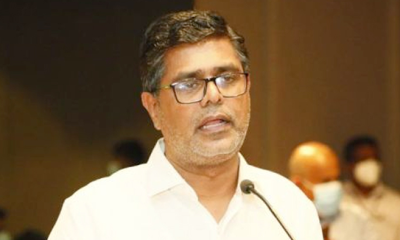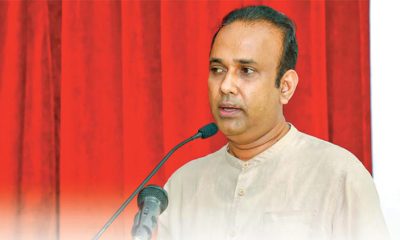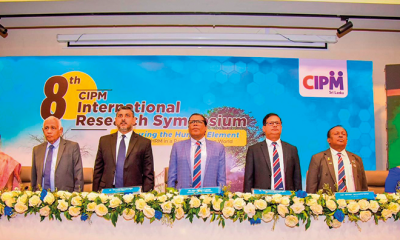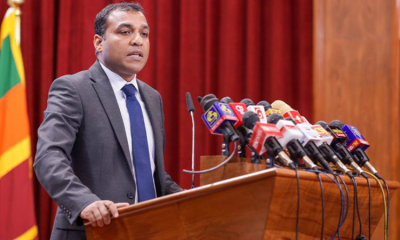Features
Lies about pigeons
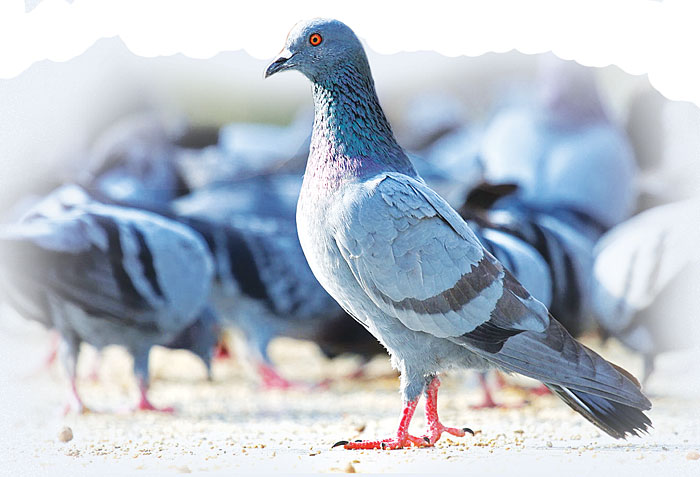
A month ago I received distress calls from people in Mumbai that the Municipal Commissioner had suddenly swooped down on a 20-year-old feeding platform (chabutra) for pigeons, which was on the side of the road in Khar, had covered it with plastic sheets and posted police people so that no one could feed the birds. The pigeons left inside died of starvation as they were not allowed out. The pigeons outside, who had been fed for years, had nowhere else to go so they stayed on the road waiting to be fed. Hundreds were run over by cars. Anyone who tried to feed them was made to sit in a police station. In the meantime the Municipal Commissioner had several completely untrue articles published in the local papers about how dangerous pigeons are to human health.
I talked to the Commissioner and this is the reason he gave me for this unnecessary and murderous act : Pigeons lay eggs. The eggs are eaten by crows. We don’t want crows. So if we get rid of pigeons, the crows will leave.
I have rarely heard such complete nonsense. There is no scientific proof of any link between pigeon eggs and crow breeding. Crows are scavengers. They will continue to breed as long as humans generate filth.
We need to know why pigeons are in the cities. Thousands of people feed them – in Delhi there are designated feeding areas and people come in scooters and cars to throw feed. My hospital has over a thousand pigeons that have been hurt by cats, dogs and cars.
There are no pigeons in the wild any more.
How did they become city creatures like dogs and cats ?
The pigeon we know today is a descendant of the Rock Dove (Columbia Livia) which prefers rocky coastal cliffs to cities. As far back as 10,000 years ago records show that people in Mesopotamia (now Iraq) and Egypt began coxing them with food and encouraging them to feed and breed near human dwellings. These birds were then caught and eaten. People started breeding them like chickens to eat. And the breeding and domestication led to the subspecies in our cities today.
Over time, people stopped eating them and started breeding them as a hobby. Pigeons were transported all over the world by ship to feed the pigeon breeding hobby. Obviously many escaped and began to breed freely in the cities. They had been bred over time to be comfortable with humans and so they took up nesting on building ledges, window sills: anything that looked like a cliff edge.
People realized that pigeons had a talent for navigation, and sailors used them to point lost ships towards land. They became valuable as airborne messengers and even armies started using them. Pigeon posts were recognized all over the world. Genghis Khan used pigeons as daily messengers both to enemies and allies. They were used widely in both World Wars. America alone used 200,000 in the Second World War. Medals for bravery were given to pigeons. The last messaging service using pigeons in the world was disbanded in 2006 by the police force in the state of Odisha !
By then pigeons had also adapted their appetites from berries, insects and seeds to anything that humans would feed them – from grain to ice cream and biscuits – and they became expert trash hunters. There is a lovely film on You Tube about a pigeon in Canada that steals a bag of chips from a shop every day !
 Their breeding biology is good for the survival of their children : both parents rear their chicks on a diet of protein-and fat-rich milk produced in a throat pouch called the crop, instead of relying on insects, worms and seeds to keep their young alive. As long as they can eat, their babies will survive.
Their breeding biology is good for the survival of their children : both parents rear their chicks on a diet of protein-and fat-rich milk produced in a throat pouch called the crop, instead of relying on insects, worms and seeds to keep their young alive. As long as they can eat, their babies will survive.
So, when other birds finally gave up the ability to survive in the harsh urban environment and died out, the pigeon survives. Along with the crow, it is the only bird that most city children will ever see. Children, who are allowed to feed them, remember the experience years later and how it shaped their personalities into becoming more humane people.
What is there to hate in pigeons ? They are good looking with iridescent necks and so many colours. People, who have adopted injured pigeons who cannot fly any more, say that they are beloved members of the household. Charming, affectionate, sociable with individual personalities. When they live indoors, they keep themselves very clean and love bathing ! They are easy to potty train. They are important to the cleanliness of a city. Crows are still too shy to walk around with people. But pigeons eat all the trash that we throw on the sidewalk, even the vomit. They are smart with complex social systems. I think that they think they are people too.
What is their importance ? We need hawks, eagles, falcons and kites, and pigeons are a food for them.
Pigeon compost is considered the best of all manures. In early history perhaps the domestication of pigeons led to advances in the ability to grow the best possible crops. Pigeon faeces was so valuable that armed guards were hired to protect dovecotes from thieves. In the Middle East, where eating pigeon flesh was forbidden, dovecotes were built simply to provide manure for growing fruit and this practice continued for centuries. In France, Italy and Spain guano was used extensively on hemp crops and for the fertilisation of vineyards. It is extremely nitrogen rich. There are ads on the net advertising pigeon manure which sells for twice the price of other manures. Their compost is unsurpassed for fertilizing tomatoes, watermelon, eggplant, roses, and other plants that like a rich soil.
In Morocco pigeons’ droppings are collected and sold to leather tanneries as when leather is soaked in pigeon faeces it becomes more supple . Moroccan leather is considered the best in the world.
Who hates them ? The same people who drove out sparrows, wrens, warblers, blue jays, cardinals, egrets, and everything else. The same people who choose sterile joyless streets as a representation of “cleanliness” and “development” over human happiness.
And they make up these stories about disease spreading.
Do pigeons spread disease ? No. If they did they would not have been eaten for centuries without a single case of disease reported. In the 19th century the American government urged people to collect pigeons and eat them for protein.
Ironically, the pigeon is now wrongly perceived as a disease carrier as a result of commercial propaganda pumped out by the pest control industry, with America being the source of a majority of this misinformation – the same country that urges you to eat them.
Every country bureaucrat (never scientists) accuses the pigeon of spreading everything. The Mumbai Commissioner has accused them of tuberculosis. The Municipal Commissioner of New York spread stories about pigeons spreading meningitis. He had to apologise publicly.
The pest control industry pumps out propaganda suggesting that pigeons are disease carriers. In reality they pose little or no risk at all. I have a staff of people who look after diseased and sick pigeons . Not one person – and they work without gloves and face protectors – has ever fallen sick in the last 40 years.
Do pigeons, or their excrement, transmit diseases to human beings ? The answer is no, they do not. The likelihood of a bird passing on a disease to a human being is so infinitesimally small that it is not even worth considering.
Below are quotes from leading experts in respect of the potential for pigeons to transmit disease to human beings:
* The Center for Disease Control in Atlanta, the New York City Department of Health, and the Arizona Department of Health, all agree that diseases associated with pigeons present little risk to people. None of them has documented a SINGLE case of pigeon to human transmission of any disease.
* The UK’s Chief Veterinary Officer, when addressing the House of Lords in 2000 on the issue of intimate human contact with 8,000 pigeons feeding in
Trafalgar Square, was asked if this represented a risk to human health. The Chief Veterinary Officer told The House that it did not.
* The Cincinnati Environment Advisory Council report: “The truth is that the vast majority of people are at little or no health risk from pigeons and probably have a greater chance of being struck by lightning than contracting a disease from pigeons.”
* Mike Everett, Royal Society for the Protection of Birds, in The Big Issue Magazine, February 2001: “There is no evidence to show that pigeons spread disease.”
* David A. Palmer (B.V.Sc., M.R.C.V.S) said in an article entitled ‘Pigeon Lung Disease Fatality and Health Risk from Ferals’: “It really makes absolute nonsense for a popular daily newspaper to suggest that pigeons present a health hazard.”
* David Taylor BVMS FRCVS FZS: “In 50 years professional work as a veterinary surgeon I cannot recall one case of a zoonosis in a human that was related to pigeons.”
Many professions, such as those involved in veterinary medicine and wildlife rehabilitation, treat wild birds suffering from a variety of avian diseases on a daily basis. Those involved in the sport of racing pigeons also spend a great deal of time in dusty pigeon lofts that accommodate hundreds of pigeons. If the potential for the transmission of disease is so great, why is it that we do not see regular human fatalities in these professions and sports where close contact with birds, such as pigeons, is commonplace?
Four major studies done across the world in 1983/1993/ 1996 /2002 have confirmed that not only does the pigeon not carry any avian influenza, it is highly resistant to the disease, cannot be infected with it and cannot spread the disease.
How to reduce pigeon numbers in the city ? The answer is very simple. Making pigeon chabutaras and designated feeding sites, and using pigeon lofts where eggs can be removed, has been proven to be successful in every city where it has been tried. If the Mumbai Municipal Commissioner wants to reduce pigeons, it can only be done by establishing chabutaras, not by removing them.
To join the animal welfare movement contact gandhim@nic.in, www.peopleforanimalsindia.org
Features
The heart-friendly health minister

by Dr Gotabhya Ranasinghe
Senior Consultant Cardiologist
National Hospital Sri Lanka
When we sought a meeting with Hon Dr. Ramesh Pathirana, Minister of Health, he graciously cleared his busy schedule to accommodate us. Renowned for his attentive listening and deep understanding, Minister Pathirana is dedicated to advancing the health sector. His openness and transparency exemplify the qualities of an exemplary politician and minister.
Dr. Palitha Mahipala, the current Health Secretary, demonstrates both commendable enthusiasm and unwavering support. This combination of attributes makes him a highly compatible colleague for the esteemed Minister of Health.
Our discussion centered on a project that has been in the works for the past 30 years, one that no other minister had managed to advance.
Minister Pathirana, however, recognized the project’s significance and its potential to revolutionize care for heart patients.
The project involves the construction of a state-of-the-art facility at the premises of the National Hospital Colombo. The project’s location within the premises of the National Hospital underscores its importance and relevance to the healthcare infrastructure of the nation.
This facility will include a cardiology building and a tertiary care center, equipped with the latest technology to handle and treat all types of heart-related conditions and surgeries.
Securing funding was a major milestone for this initiative. Minister Pathirana successfully obtained approval for a $40 billion loan from the Asian Development Bank. With the funding in place, the foundation stone is scheduled to be laid in September this year, and construction will begin in January 2025.
This project guarantees a consistent and uninterrupted supply of stents and related medications for heart patients. As a result, patients will have timely access to essential medical supplies during their treatment and recovery. By securing these critical resources, the project aims to enhance patient outcomes, minimize treatment delays, and maintain the highest standards of cardiac care.
Upon its fruition, this monumental building will serve as a beacon of hope and healing, symbolizing the unwavering dedication to improving patient outcomes and fostering a healthier society.We anticipate a future marked by significant progress and positive outcomes in Sri Lanka’s cardiovascular treatment landscape within the foreseeable timeframe.
Features
A LOVING TRIBUTE TO JESUIT FR. ALOYSIUS PIERIS ON HIS 90th BIRTHDAY

by Fr. Emmanuel Fernando, OMI
Jesuit Fr. Aloysius Pieris (affectionately called Fr. Aloy) celebrated his 90th birthday on April 9, 2024 and I, as the editor of our Oblate Journal, THE MISSIONARY OBLATE had gone to press by that time. Immediately I decided to publish an article, appreciating the untiring selfless services he continues to offer for inter-Faith dialogue, the renewal of the Catholic Church, his concern for the poor and the suffering Sri Lankan masses and to me, the present writer.
It was in 1988, when I was appointed Director of the Oblate Scholastics at Ampitiya by the then Oblate Provincial Fr. Anselm Silva, that I came to know Fr. Aloy more closely. Knowing well his expertise in matters spiritual, theological, Indological and pastoral, and with the collaborative spirit of my companion-formators, our Oblate Scholastics were sent to Tulana, the Research and Encounter Centre, Kelaniya, of which he is the Founder-Director, for ‘exposure-programmes’ on matters spiritual, biblical, theological and pastoral. Some of these dimensions according to my view and that of my companion-formators, were not available at the National Seminary, Ampitiya.
Ever since that time, our Oblate formators/ accompaniers at the Oblate Scholasticate, Ampitiya , have continued to send our Oblate Scholastics to Tulana Centre for deepening their insights and convictions regarding matters needed to serve the people in today’s context. Fr. Aloy also had tried very enthusiastically with the Oblate team headed by Frs. Oswald Firth and Clement Waidyasekara to begin a Theologate, directed by the Religious Congregations in Sri Lanka, for the contextual formation/ accompaniment of their members. It should very well be a desired goal of the Leaders / Provincials of the Religious Congregations.
Besides being a formator/accompanier at the Oblate Scholasticate, I was entrusted also with the task of editing and publishing our Oblate journal, ‘The Missionary Oblate’. To maintain the quality of the journal I continue to depend on Fr. Aloy for his thought-provoking and stimulating articles on Biblical Spirituality, Biblical Theology and Ecclesiology. I am very grateful to him for his generous assistance. Of late, his writings on renewal of the Church, initiated by Pope St. John XX111 and continued by Pope Francis through the Synodal path, published in our Oblate journal, enable our readers to focus their attention also on the needed renewal in the Catholic Church in Sri Lanka. Fr. Aloy appreciated very much the Synodal path adopted by the Jesuit Pope Francis for the renewal of the Church, rooted very much on prayerful discernment. In my Religious and presbyteral life, Fr.Aloy continues to be my spiritual animator / guide and ongoing formator / acccompanier.
Fr. Aloysius Pieris, BA Hons (Lond), LPh (SHC, India), STL (PFT, Naples), PhD (SLU/VC), ThD (Tilburg), D.Ltt (KU), has been one of the eminent Asian theologians well recognized internationally and one who has lectured and held visiting chairs in many universities both in the West and in the East. Many members of Religious Congregations from Asian countries have benefited from his lectures and guidance in the East Asian Pastoral Institute (EAPI) in Manila, Philippines. He had been a Theologian consulted by the Federation of Asian Bishops’ Conferences for many years. During his professorship at the Gregorian University in Rome, he was called to be a member of a special group of advisers on other religions consulted by Pope Paul VI.
Fr. Aloy is the author of more than 30 books and well over 500 Research Papers. Some of his books and articles have been translated and published in several countries. Among those books, one can find the following: 1) The Genesis of an Asian Theology of Liberation (An Autobiographical Excursus on the Art of Theologising in Asia, 2) An Asian Theology of Liberation, 3) Providential Timeliness of Vatican 11 (a long-overdue halt to a scandalous millennium, 4) Give Vatican 11 a chance, 5) Leadership in the Church, 6) Relishing our faith in working for justice (Themes for study and discussion), 7) A Message meant mainly, not exclusively for Jesuits (Background information necessary for helping Francis renew the Church), 8) Lent in Lanka (Reflections and Resolutions, 9) Love meets wisdom (A Christian Experience of Buddhism, 10) Fire and Water 11) God’s Reign for God’s poor, 12) Our Unhiddden Agenda (How we Jesuits work, pray and form our men). He is also the Editor of two journals, Vagdevi, Journal of Religious Reflection and Dialogue, New Series.
Fr. Aloy has a BA in Pali and Sanskrit from the University of London and a Ph.D in Buddhist Philosophy from the University of Sri Lankan, Vidyodaya Campus. On Nov. 23, 2019, he was awarded the prestigious honorary Doctorate of Literature (D.Litt) by the Chancellor of the University of Kelaniya, the Most Venerable Welamitiyawe Dharmakirthi Sri Kusala Dhamma Thera.
Fr. Aloy continues to be a promoter of Gospel values and virtues. Justice as a constitutive dimension of love and social concern for the downtrodden masses are very much noted in his life and work. He had very much appreciated the commitment of the late Fr. Joseph (Joe) Fernando, the National Director of the Social and Economic Centre (SEDEC) for the poor.
In Sri Lanka, a few religious Congregations – the Good Shepherd Sisters, the Christian Brothers, the Marist Brothers and the Oblates – have invited him to animate their members especially during their Provincial Congresses, Chapters and International Conferences. The mainline Christian Churches also have sought his advice and followed his seminars. I, for one, regret very much, that the Sri Lankan authorities of the Catholic Church –today’s Hierarchy—- have not sought Fr.
Aloy’s expertise for the renewal of the Catholic Church in Sri Lanka and thus have not benefited from the immense store of wisdom and insight that he can offer to our local Church while the Sri Lankan bishops who governed the Catholic church in the immediate aftermath of the Second Vatican Council (Edmund Fernando OMI, Anthony de Saram, Leo Nanayakkara OSB, Frank Marcus Fernando, Paul Perera,) visited him and consulted him on many matters. Among the Tamil Bishops, Bishop Rayappu Joseph was keeping close contact with him and Bishop J. Deogupillai hosted him and his team visiting him after the horrible Black July massacre of Tamils.
Features
A fairy tale, success or debacle

Sri Lanka-Singapore Free Trade Agreement
By Gomi Senadhira
senadhiragomi@gmail.com
“You might tell fairy tales, but the progress of a country cannot be achieved through such narratives. A country cannot be developed by making false promises. The country moved backward because of the electoral promises made by political parties throughout time. We have witnessed that the ultimate result of this is the country becoming bankrupt. Unfortunately, many segments of the population have not come to realize this yet.” – President Ranil Wickremesinghe, 2024 Budget speech
Any Sri Lankan would agree with the above words of President Wickremesinghe on the false promises our politicians and officials make and the fairy tales they narrate which bankrupted this country. So, to understand this, let’s look at one such fairy tale with lots of false promises; Ranil Wickremesinghe’s greatest achievement in the area of international trade and investment promotion during the Yahapalana period, Sri Lanka-Singapore Free Trade Agreement (SLSFTA).
It is appropriate and timely to do it now as Finance Minister Wickremesinghe has just presented to parliament a bill on the National Policy on Economic Transformation which includes the establishment of an Office for International Trade and the Sri Lanka Institute of Economics and International Trade.
Was SLSFTA a “Cleverly negotiated Free Trade Agreement” as stated by the (former) Minister of Development Strategies and International Trade Malik Samarawickrama during the Parliamentary Debate on the SLSFTA in July 2018, or a colossal blunder covered up with lies, false promises, and fairy tales? After SLSFTA was signed there were a number of fairy tales published on this agreement by the Ministry of Development Strategies and International, Institute of Policy Studies, and others.
However, for this article, I would like to limit my comments to the speech by Minister Samarawickrama during the Parliamentary Debate, and the two most important areas in the agreement which were covered up with lies, fairy tales, and false promises, namely: revenue loss for Sri Lanka and Investment from Singapore. On the other important area, “Waste products dumping” I do not want to comment here as I have written extensively on the issue.
1. The revenue loss
During the Parliamentary Debate in July 2018, Minister Samarawickrama stated “…. let me reiterate that this FTA with Singapore has been very cleverly negotiated by us…. The liberalisation programme under this FTA has been carefully designed to have the least impact on domestic industry and revenue collection. We have included all revenue sensitive items in the negative list of items which will not be subject to removal of tariff. Therefore, 97.8% revenue from Customs duty is protected. Our tariff liberalisation will take place over a period of 12-15 years! In fact, the revenue earned through tariffs on goods imported from Singapore last year was Rs. 35 billion.
The revenue loss for over the next 15 years due to the FTA is only Rs. 733 million– which when annualised, on average, is just Rs. 51 million. That is just 0.14% per year! So anyone who claims the Singapore FTA causes revenue loss to the Government cannot do basic arithmetic! Mr. Speaker, in conclusion, I call on my fellow members of this House – don’t mislead the public with baseless criticism that is not grounded in facts. Don’t look at petty politics and use these issues for your own political survival.”
I was surprised to read the minister’s speech because an article published in January 2018 in “The Straits Times“, based on information released by the Singaporean Negotiators stated, “…. With the FTA, tariff savings for Singapore exports are estimated to hit $10 million annually“.
As the annual tariff savings (that is the revenue loss for Sri Lanka) calculated by the Singaporean Negotiators, Singaporean $ 10 million (Sri Lankan rupees 1,200 million in 2018) was way above the rupees’ 733 million revenue loss for 15 years estimated by the Sri Lankan negotiators, it was clear to any observer that one of the parties to the agreement had not done the basic arithmetic!
Six years later, according to a report published by “The Morning” newspaper, speaking at the Committee on Public Finance (COPF) on 7th May 2024, Mr Samarawickrama’s chief trade negotiator K.J. Weerasinghehad had admitted “…. that forecasted revenue loss for the Government of Sri Lanka through the Singapore FTA is Rs. 450 million in 2023 and Rs. 1.3 billion in 2024.”
If these numbers are correct, as tariff liberalisation under the SLSFTA has just started, we will pass Rs 2 billion very soon. Then, the question is how Sri Lanka’s trade negotiators made such a colossal blunder. Didn’t they do their basic arithmetic? If they didn’t know how to do basic arithmetic they should have at least done their basic readings. For example, the headline of the article published in The Straits Times in January 2018 was “Singapore, Sri Lanka sign FTA, annual savings of $10m expected”.
Anyway, as Sri Lanka’s chief negotiator reiterated at the COPF meeting that “…. since 99% of the tariffs in Singapore have zero rates of duty, Sri Lanka has agreed on 80% tariff liberalisation over a period of 15 years while expecting Singapore investments to address the imbalance in trade,” let’s turn towards investment.
Investment from Singapore
In July 2018, speaking during the Parliamentary Debate on the FTA this is what Minister Malik Samarawickrama stated on investment from Singapore, “Already, thanks to this FTA, in just the past two-and-a-half months since the agreement came into effect we have received a proposal from Singapore for investment amounting to $ 14.8 billion in an oil refinery for export of petroleum products. In addition, we have proposals for a steel manufacturing plant for exports ($ 1 billion investment), flour milling plant ($ 50 million), sugar refinery ($ 200 million). This adds up to more than $ 16.05 billion in the pipeline on these projects alone.
And all of these projects will create thousands of more jobs for our people. In principle approval has already been granted by the BOI and the investors are awaiting the release of land the environmental approvals to commence the project.
I request the Opposition and those with vested interests to change their narrow-minded thinking and join us to develop our country. We must always look at what is best for the whole community, not just the few who may oppose. We owe it to our people to courageously take decisions that will change their lives for the better.”
According to the media report I quoted earlier, speaking at the Committee on Public Finance (COPF) Chief Negotiator Weerasinghe has admitted that Sri Lanka was not happy with overall Singapore investments that have come in the past few years in return for the trade liberalisation under the Singapore-Sri Lanka Free Trade Agreement. He has added that between 2021 and 2023 the total investment from Singapore had been around $162 million!
What happened to those projects worth $16 billion negotiated, thanks to the SLSFTA, in just the two-and-a-half months after the agreement came into effect and approved by the BOI? I do not know about the steel manufacturing plant for exports ($ 1 billion investment), flour milling plant ($ 50 million) and sugar refinery ($ 200 million).
However, story of the multibillion-dollar investment in the Petroleum Refinery unfolded in a manner that would qualify it as the best fairy tale with false promises presented by our politicians and the officials, prior to 2019 elections.
Though many Sri Lankans got to know, through the media which repeatedly highlighted a plethora of issues surrounding the project and the questionable credentials of the Singaporean investor, the construction work on the Mirrijiwela Oil Refinery along with the cement factory began on the24th of March 2019 with a bang and Minister Ranil Wickremesinghe and his ministers along with the foreign and local dignitaries laid the foundation stones.
That was few months before the 2019 Presidential elections. Inaugurating the construction work Prime Minister Ranil Wickremesinghe said the projects will create thousands of job opportunities in the area and surrounding districts.
The oil refinery, which was to be built over 200 acres of land, with the capacity to refine 200,000 barrels of crude oil per day, was to generate US$7 billion of exports and create 1,500 direct and 3,000 indirect jobs. The construction of the refinery was to be completed in 44 months. Four years later, in August 2023 the Cabinet of Ministers approved the proposal presented by President Ranil Wickremesinghe to cancel the agreement with the investors of the refinery as the project has not been implemented! Can they explain to the country how much money was wasted to produce that fairy tale?
It is obvious that the President, ministers, and officials had made huge blunders and had deliberately misled the public and the parliament on the revenue loss and potential investment from SLSFTA with fairy tales and false promises.
As the president himself said, a country cannot be developed by making false promises or with fairy tales and these false promises and fairy tales had bankrupted the country. “Unfortunately, many segments of the population have not come to realize this yet”.
(The writer, a specialist and an activist on trade and development issues . )




